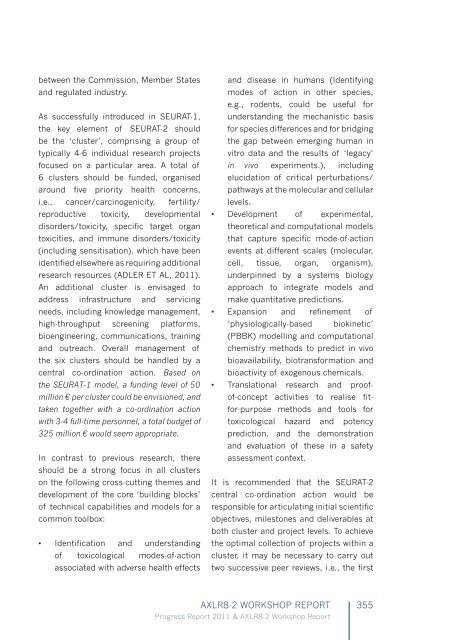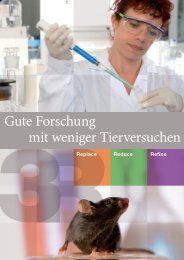You also want an ePaper? Increase the reach of your titles
YUMPU automatically turns print PDFs into web optimized ePapers that Google loves.
etween the Commission, Member States<br />
and regulated industry.<br />
As successfully introduced in SEURAT-1,<br />
the key element of SEURAT-2 should<br />
be the ‘cluster’, comprising a group of<br />
typically 4-6 individual research projects<br />
focused on a particular area. A total of<br />
6 clusters should be funded, organised<br />
around five priority health concerns,<br />
i.e., cancer/carcinogenicity, fertility/<br />
reproductive toxicity, developmental<br />
disorders/toxicity, specific target organ<br />
toxicities, and immune disorders/toxicity<br />
(including sensitisation), which have been<br />
identified elsewhere as requiring additional<br />
research resources (ADLER ET AL, 2011).<br />
An additional cluster is envisaged to<br />
address infrastructure and servicing<br />
needs, including knowledge management,<br />
high-throughput screening platforms,<br />
bioengineering, communications, training<br />
and outreach. Overall management of<br />
the six clusters should be handled by a<br />
central co-ordination action. Based on<br />
the SEURAT-1 model, a funding level of 50<br />
million € per cluster could be envisioned, and<br />
taken together with a co-ordination action<br />
with 3-4 full-time personnel, a total budget of<br />
325 million € would seem appropriate.<br />
In contrast to previous research, there<br />
should be a strong focus in all clusters<br />
on the following cross-cutting themes and<br />
development of the core ‘building blocks’<br />
of technical capabilities and models for a<br />
common toolbox:<br />
• Identification and understanding<br />
of toxicological modes-of-action<br />
associated with adverse health effects<br />
and disease in humans (Identifying<br />
modes of action in other species,<br />
e.g., rodents, could be useful for<br />
understanding the mechanistic basis<br />
for species differences and for bridging<br />
the gap between emerging human in<br />
vitro data and the results of ‘legacy’<br />
in vivo experiments.), including<br />
elucidation of critical perturbations/<br />
pathways at the molecular and cellular<br />
levels.<br />
• Development of experimental,<br />
theoretical and computational models<br />
that capture specific mode-of-action<br />
events at different scales (molecular,<br />
cell, tissue, organ, organism),<br />
underpinned by a systems biology<br />
approach to integrate models and<br />
make quantitative predictions.<br />
• Expansion and refinement of<br />
‘physiologically-based biokinetic’<br />
(PBBK) modelling and computational<br />
chemistry methods to predict in vivo<br />
bioavailability, biotransformation and<br />
bioactivity of exogenous chemicals.<br />
• Translational research and proofof-concept<br />
activities to realise fitfor-purpose<br />
methods and tools for<br />
toxicological hazard and potency<br />
prediction, and the demonstration<br />
and evaluation of these in a safety<br />
assessment context.<br />
It is recommended that the SEURAT-2<br />
central co-ordination action would be<br />
responsible for articulating initial scientific<br />
objectives, milestones and deliverables at<br />
both cluster and project levels. To achieve<br />
the optimal collection of projects within a<br />
cluster, it may be necessary to carry out<br />
two successive peer reviews, i.e., the first<br />
AXLR8-2 WORKSHOP REPORT<br />
Progress Report 2011 & AXLR8-2 Workshop Report<br />
355




